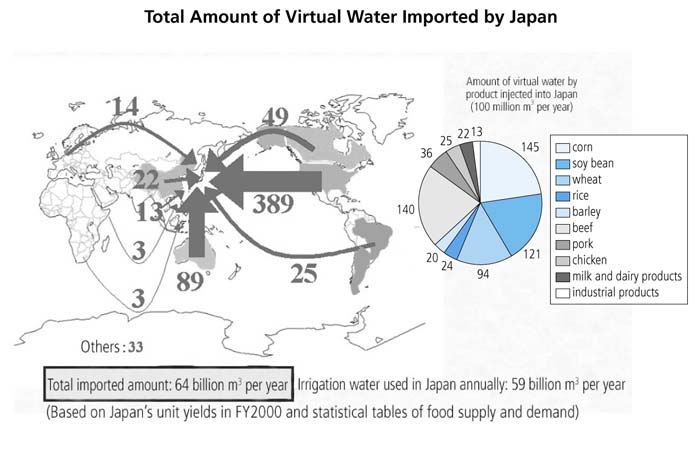Japan's Official Development Assistance White Paper 2006
Box II-3. Japan's Overseas Dependency for Food as Measured by Virtual Water
Japan imports massive volumes of farm and livestock products and industrial goods. If all these products were produced domestically, Japan would need a massive amount of water. This type of water, assumed to be necessary when imported food is produced domestically, is called virtual water. In other words, importing food means importing virtual water, which in turn results in saving massive water resources in the importing country.
A university team has estimated how much water is needed to produce one kilogram of food. White rice needs 3,600 liters; wheat 2,000 liters; chicken 4,500 liters; and beef 20,000 liters, according to the team led by Associate Professor Taikan Oki of the Institute of Industrial Science (IIS), University of Tokyo. For example, a bowl of rice topped with beef would need 1,890 liters of virtual water, based on this calculation. All summed up, the chart below shows the total amount of virtual water imported by Japan. The annual volume reaches 64 billion cubic meters. This is about three fourths of the total volume of water Japan consumes at home annually—83.9 billion cubic meters in 2003.1
As Japan largely depends on overseas water resources, the country also actively assists the water supply of developing countries, including drinking water and agricultural water. The amount of bilateral assistance in the areas of water and sanitation totaled US$4.6 billion for the five years from 2000 to 2004, and accounts for 41% of the total contribution by DAC countries. Also, as a result of yen loan projects related to the improvement of water supply and sewage which have been implemented since the 1980s, more than 100 million people around the world have gained access to safe drinking water. In this way Japan assists in improving water problems in developing countries.

Source: Personal sites of Dr. Taikan Oki
(http://hydro.iis.u-tokyo.ac.jp/Info/Press200207/Img2003-01/vw2003-0130_08.jpg
 )
)

 Next Page
Next Page